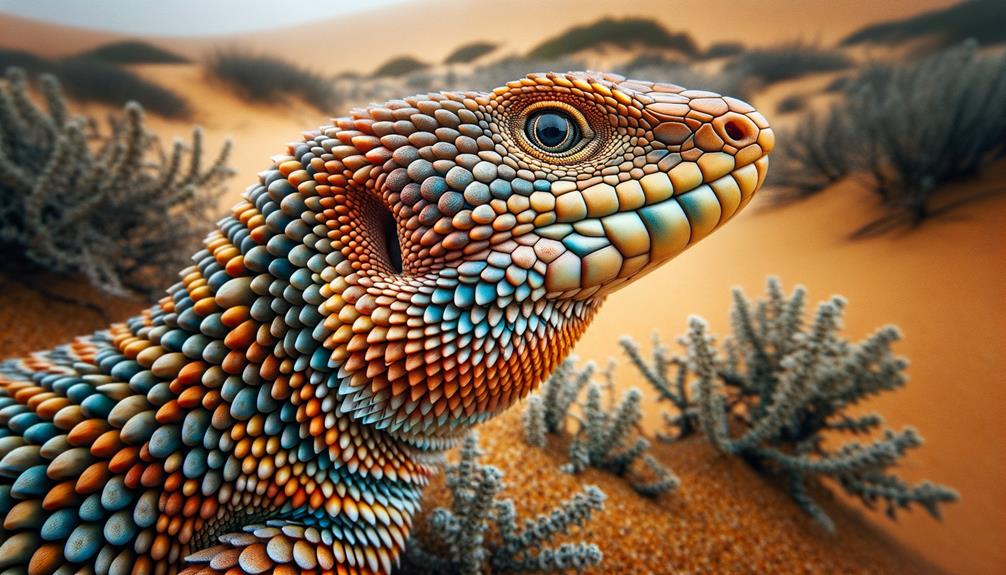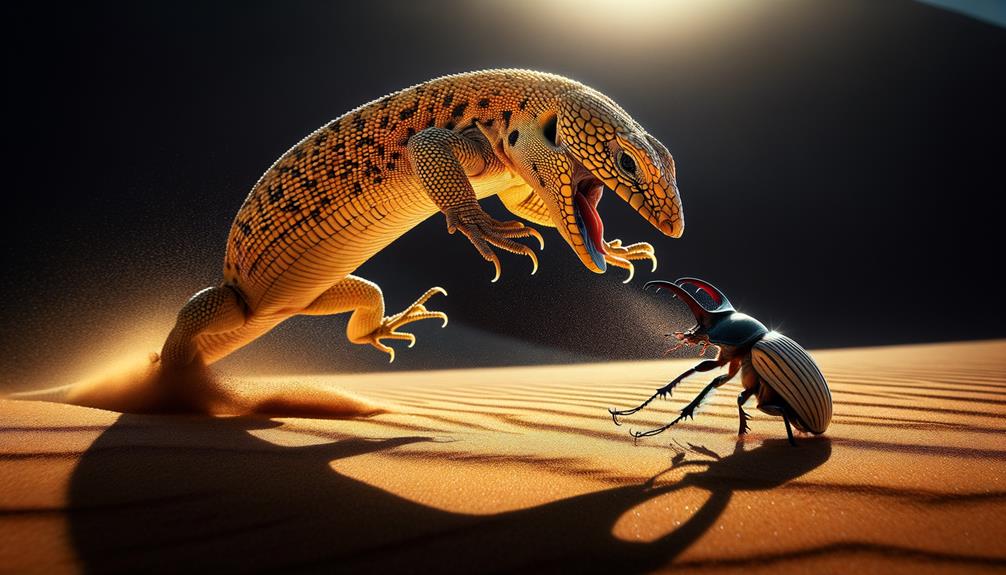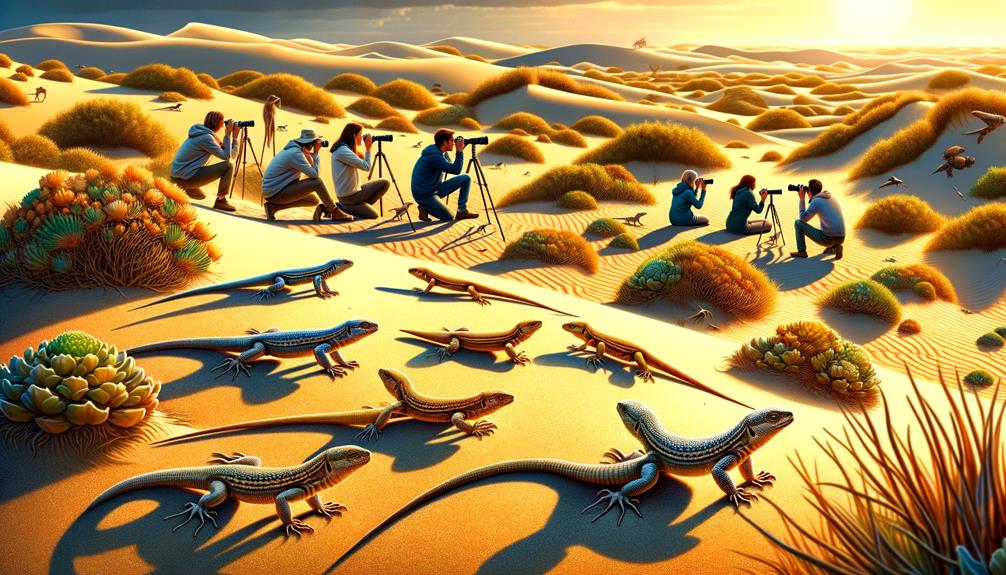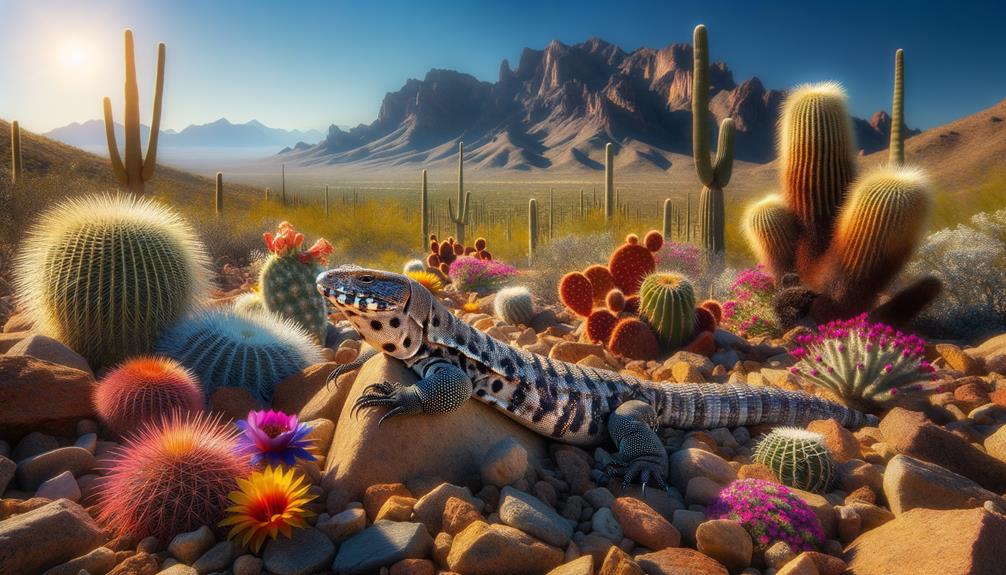Namib sand lizards are remarkable creatures that can survive in scorching temperatures above 70°C. These hardy reptiles roam the coastal deserts of Namibia, using their unique scales and wide, fringed feet to navigate both sandy dunes and rocky terrain. They've developed clever ways to stay hydrated, including lapping up dewdrops, and use their sticky tongues to snag insects with impressive accuracy. The toughness and flexibility of these lizards are truly impressive, but there's more to their story that deserves attention.
These lizards have adapted to one of the harshest environments on Earth, showcasing nature's ability to thrive in extreme conditions. Their survival strategies offer insights into how life can persist in seemingly inhospitable places. Scientists continue to study these resilient creatures, hoping to uncover more about their physiology and behavior.
The Namib sand lizard's ability to withstand such high temperatures raises questions about the limits of life and how species might adapt to changing climates. As global temperatures rise, understanding these adaptations could prove valuable for conservation efforts and climate change research.
Habitat and Environment
Namib Sand Lizards call the harsh coastal Namib Desert home. They're right at home on sandy dunes, rocky outcrops, and among sparse vegetation. This desert isn't for the faint-hearted – temperatures can hit a scorching 70°C (158°F). Yet these tough little creatures have figured out how to not just survive, but thrive in these extreme conditions.
Their world is a challenging one, with vast sand dunes and rocky terrain offering few water sources. These resourceful lizards make do with what little moisture they can find, often relying on dewdrops clinging to sparse vegetation. They've developed some nifty tricks to cope with their harsh environment. Their scales are specially designed to keep sand out, letting them scurry across the dunes without getting bogged down.
These lizards have another clever adaptation – wide feet with fringes. This unique feature helps them stay on top of the soft sand instead of sinking in, making it easier to move around. And when it comes to avoiding predators, their camouflage is top-notch. Their coloring blends seamlessly with the desert landscape, making them nearly invisible to threats.
It's pretty remarkable how well-suited these lizards are to one of the world's toughest environments. Their adaptations aren't just about survival – they've truly mastered desert living.
Physical Characteristics

Namib sand lizards have a remarkable set of features that help them thrive in the harsh Namib Desert. Their scales are designed to keep sand out while allowing them to blend in with their surroundings. With long limbs and tails, these lizards move easily across the dunes and gravel plains.
Their feet are wide and fringed, much like a web-footed gecko's, which stops them from sinking into soft sand. These adaptations, along with special plates and tiny hooks, let them dive into the sand to escape danger or extreme heat. Sharp eyesight, thanks to vertical pupils, helps them spot movement, which is crucial for hunting at night.
These lizards also have see-through scales over their eyes for protection against sand and dust. Sticky pads on their feet, similar to those on geckos, give them a good grip on rocks, even when occasional rain makes surfaces slippery. Growing up to 20 cm long, these tough creatures can handle temperatures as high as 70°C, showing just how well they've adapted to one of the world's toughest environments.
Reproductive Behavior

When the rains come to the Namib Desert, sand lizards kick off their breeding season. These tough little creatures time their mating perfectly, taking advantage of the softer sand to build nests. Female lizards typically lay between two and five eggs in carefully chosen spots.
The desert's harsh conditions mean these eggs take a long time to hatch. The sand acts as a protective blanket, keeping the developing babies safe and at the right temperature. Once they emerge, the young lizards are on their own from day one. They need to quickly figure out how to survive in this unforgiving environment, relying on their instincts and natural toughness.
Studying how these lizards reproduce is key to protecting them. As the climate shifts and their homes are destroyed, the future of Namib sand lizards hangs in the balance. Conservation efforts need to focus on preserving their natural habitats and reducing the impact of environmental changes. By doing this, we can help ensure these remarkable reptiles stick around and keep the desert's ecosystem in check.
Diet and Hunting

As the sun sets, Namib sand lizards come alive, their nightly hunt beginning in the coastal desert. These hardy creatures have mastered the art of catching insects using their quick, sticky tongues. Their menu mainly consists of ants, termites, beetles, and spiders – a diet born of necessity in their harsh environment.
The lizards' nocturnal habits aren't just a quirk; they're a smart move to beat the scorching daytime heat. Every meal is a testament to their adaptability, with different tactics for each prey:
| Insects | Hunting Approach |
|---|---|
| Ants | Rapid tongue strikes |
| Termites | Sneaky burrow raids |
| Beetles | Silent stalking |
| Spiders | Lightning-fast grabs |
These lizards can go long stretches without food, a handy skill in a place where meals are hard to come by. Their knack for finding food in such a tough spot shows just how well they've adapted to desert life.
While they're on the IUCN Red List, Namib sand lizards keep on trucking. They're living proof that with the right skills, even the harshest places can be home. Night after night, they remind us that life finds a way, even in the most unlikely spots.
Conservation Efforts

Namib sand lizards are tough, but they still need our help. These amazing creatures face serious risks from habitat loss and changing climate, even though they're not currently endangered. That's why ongoing protection efforts are crucial.
National parks in the Namib Desert play a key role. They create safe spaces where these lizards can live without much human interference. Scientists, including those from Johns Hopkins University, are also doing important work. They're studying how environmental shifts might affect these hardy reptiles in the long run.
Some main strategies to protect Namib sand lizards include:
- Safeguarding their homes by setting up and maintaining national parks
- Carrying out research to understand how climate change impacts their survival
- Raising public awareness about why it matters to protect these unique animals
These actions don't just help the lizards. They also teach us more about how species adapt to extreme environments. By focusing on these steps, we can help ensure Namib sand lizards continue to thrive despite the challenges ahead.
Frequently Asked Questions
Are There Lizards in the Namib Desert?
Lizards do indeed call the Namib Desert home. I've spotted several species there, including the fascinating Pachydactylus rangei. This gecko's unique features make it well-suited for desert life. It's active at night, with large eyes for hunting in the dark. Its webbed feet are perfect for digging into the sand. What really caught my attention, though, were its distinct sounds – not something you'd expect from a lizard. These adaptations help it thrive in such a harsh environment.
Where Do Namib Sand Geckos Live?
Namib sand geckos call the desert's harsh landscape home. These tough little lizards live in sandy spots, rocky areas, and towering dunes. You'll find them along Namibia's coast and in Richtersveld, braving scorching heat and water scarcity at heights up to 300 meters. These resilient creatures have adapted to survive in one of the world's most challenging environments, making them a fascinating subject for nature enthusiasts and scientists alike.
What Is a Trait of the Namib Desert Gecko That Makes It Unique?
The Namib Desert Gecko stands out for its see-through skin. This remarkable feature allows the lizard to blend almost invisibly with its surroundings, boosting its chances of survival. The gecko's transparent skin is a clever adaptation to the challenging desert environment. Scientists have noted how this trait helps the gecko thrive in its harsh habitat, making it a fascinating subject for researchers studying desert wildlife. The gecko's ability to camouflage so effectively showcases nature's ingenuity in evolving unique solutions to environmental pressures.
Do Sand Lizards Live in the Desert?
Sand lizards do call the desert home. Their special features, like fringed toes and nighttime hunting habits, help them handle the extreme heat and sandy terrain. It's amazing how well they've adapted to such harsh conditions. These tough little creatures have found clever ways to survive where many other animals can't.



